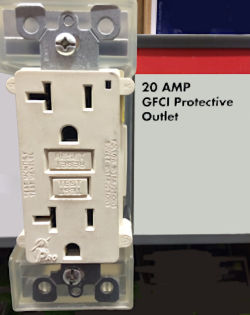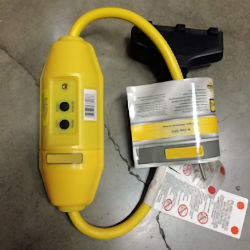Types of GFCI
Receptacle GFCI: Often found on construction work sites, outdoor areas and other locations where damp conditions do or could exist.
The receptacle GFCI fits into the standard outlet box and protects users against ground faults when an electrical product is connected to the GFCI protected outlet.
These should be tested after installation and once a month by:
- Plug in a test light or power tool and turn "On."
- Push the "Test" button on the receptacle; the "Test" button should pop up, and the power to the light or tool should be "Off."
- Push "Reset" to restore power to the outlet.
- If the above steps worked, the GFCI passed the test and is functioning properly; if the GFCI failed the test, remove it from service.
If a light or power tool remains "ON" when the "Test" button is pushed, the GFCI is not working properly or has been incorrectly installed (miswired). If this is the case, a qualified electrician needs to be contacted to properly wire or replace the GFCI device.
Portable/Temporary GFCI: A portable GFCI is an extension cord combined with a GFCI.
It adds flexibility in using receptacles that are not protected by GFCIs. Extension cords with GFCI protection incorporated should be used when permanent protection is unavailable.
These should be tested prior to each and every use by:
- visually inspecting the device for obvious defects and/or broken parts;
- plugging in a test light/tool to the extension cord;
- pushing the "Reset" button on the GFCI device;
- pushing the "Test" button to verify no voltage at outlet (e.g., the light or tool shuts off); and
- pushing the "Reset" button to verify the power is restored.
Knowledge Check Choose the best answer for the question.
2-5. Which devices should be tested at least once a month on a construction site?
You forgot to answer the question!


